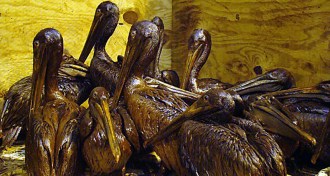Environment
-
 Health & Medicine
Health & MedicineHealth risks of e-cigarettes emerge
Research uncovers a growing list of chemicals that end up in an e-cigarette user’s lungs, and one study finds that an e-cigarette’s vapors can increase the virulence of antibiotic-resistant bacteria.
By Janet Raloff -
 Environment
EnvironmentCarbon dioxide levels hit landmark in Northern Hemisphere
The Northern Hemisphere experienced the first full month with the greenhouse gas at or above the symbolic 400 parts per million level.
By Beth Mole -
 Environment
EnvironmentFukushima contamination affects butterfly larvae
Butterfly larvae fed leaves with radioactive cesium from the Fukushima nuclear disaster had a higher rate of death and development abnormalities than larvae that got leaves from a location farther from the accident.
-
 Oceans
OceansDeepwater Horizon methane lingered longer than thought
Microbes may not have consumed methane from the 2010 Deepwater Horizon oil spill as fast as previously thought.
-
 Environment
EnvironmentBP oil spill may have killed hundreds of thousands of birds
The 2010 Deepwater Horizon oil spill may have killed 600,000 to 800,000 coastal birds, new simulations suggest.
-
 Climate
ClimateCrop nutrients may drop as carbon dioxide rises
Many staple grains and legumes pack 5 to 10 percent less iron, zinc and protein when grown at carbon dioxide levels expected midcentury.
By Beth Mole -
 Animals
AnimalsSome birds adapt to Chernobyl’s radiation
Some birds seem to fare well in and near the Chernobyl exclusion zone, but overall the nuclear disaster has been bad news for the region’s bird populations.
-
 Environment
EnvironmentPrestige oil spill linked to drop in seabird chicks
European shag in colonies affected by the 2002 Prestige oil tanker spill produced fewer chicks than birds in oil-free colonies.
-
 Environment
EnvironmentLead levels in ancient Rome’s water were high, but not toxic
Ancient Romans probably drank tap water with up to 100 times more lead than the levels found in local spring water.
-
 Health & Medicine
Health & MedicineTriclosan aids nasal invasions by staph
The antimicrobial compound triclosan, commonly found in soaps and toothpaste, may help Staphylococcus aureus stick around.
By Beth Mole -
 Environment
EnvironmentArtists’ sunsets may reveal past pollution
The colors artists used in the sunsets of their paintings may provide clues to what was circulating in the air hundreds of years ago.
-
 Environment
EnvironmentHandling receipts increases exposure to BPA
People who handle cash register receipts printed on thermal paper show notable exposure to bisphenol A.